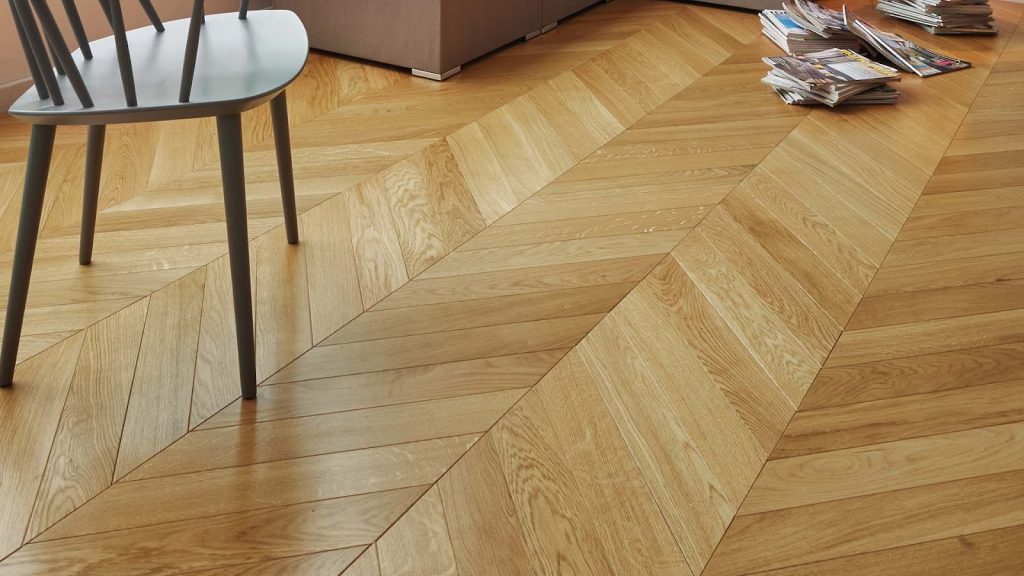Main Types Of Parquet – What to Choose?
3 min read
In this article we would like to remind you what the main types of parquet flooring are divided into and how they differ from each other. Most often, clients visually see parquet floors looking quite the same. But to choose durable parquet that will last for many years and won’t cost a pretty penny, it matters what it’s made of and how to lay it. We will talk about this further.
Solid parquet
Let’s start with a solid parquet. If we look at a board made of solid parquet, we will see a fairly thick board, which can be about 20 mm – this is a complete solid without plywood, which most often has chamfers. The chamfers are needed to hide the natural warping/cracks of the boards on the floor – they minimize the appearance of these cracks. Therefore, it is logical that a solid board is made with a chamfer, and each board looks as if it is separate, there is a certain charm in this. At Vernissage, we install solid parquet on screed or plywood using self-tapping screws and glue.
Block parquet
Block parquet differs from solid boards in that it is smaller in thickness – on average it is 15 mm and the format of the tiles itself is smaller. Block parquet is also made from solid wood and has a tongue and groove. Laying block parquet is done by gluing it to the base – the same way as solid parquet boards. Other fastening methods are not used today. In Soviet times, parquet was laid only with nails on a wooden or plywood base. Nowadays it is not customary to do this, because everyone wants the parquet to lie stable and not creak. Nail fastening means squeaks and greater warping during operation.
Engineered parquet
Engineered board differs from massive board in that it is a laminated structure:
- It has a top working layer 1-4 mm thick – this is what we see on the floor as parquet.
- Most often, the middle layer is perpendicular coniferous species.
- And the bottom layer – the backing again is, as a rule, made of plywood material longitudinally, like the top layer.
The result is three layers in a perpendicular direction. This design is considered the most stable, because each perpendicular layer holds and does not allow the engineered board to warp when humidity changes, and this is its beauty.
An engineered parquet board can have either a regular tongue-and-groove or a lock, that is, each board can be laid together with a tongue-and-groove or a lock. The lock allows you to lay engineered boards without gluing them to the base. The lock is the most important difference between lock and tongue-and-groove boards. With a lock, parquet can be laid on a substrate and also glued to the base.
Which parquet to choose for yourself
When we have roughly figured out how the main types of parquet differ, the question of choice arises – what to choose and what kind of parquet floor to make at home.
Very often the price determines the choice:
- A solid board is quite an expensive pleasure, because the board itself has a high price, it is quite difficult to install, and therefore a solid board seems to be the most expensive solution.
- Piece parquet is somewhat cheaper; it is an average category. Despite the fact that the piece parquet itself may be cheaper, the complexity of work that is necessary for laying the piece parquet still increases the total cost to quite decent prices.
- Engineered wood is perhaps the most affordable option for parquet flooring today. Most often, it already has a factory coating and is ready for installation. If you lay engineered boards using the floating method, it is quite cheap; if glued to the base – somewhat more expensive. One way or another, it does not need to be finished, sanded or coated, so it is considered the cheapest option for laying parquet.
Personally, I made my choice a long time ago: I have a piece of parquet at home. Despite the fact that there is a large complex of work, I still believe that this is the longest-lasting project – parquet, which can be updated many times, and in the future, in my opinion, it will be cheaper than any other.



